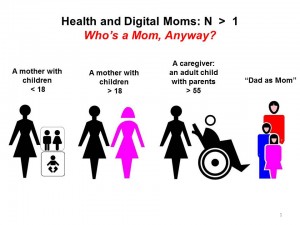 What is a Mom, and especially, who is a “Digital Mom?”
What is a Mom, and especially, who is a “Digital Mom?”
I’ve been asked to consider this question in a webinar today hosted by Enspektos, who published the report Digging Beneath the Surface: Understanding the Digital Health Mom in May 2012. I wrote my review of that study in Health Populi here on May 15.
In today’s webinar, my remarks are couched as “Caveats About the Digital Mom: a multiple persona.”
Look at the graphic. On the left, the first persona is a mother with children under 18. Most “mom segmentations” in market research focus on this segment. But what about moms with kids over 18. Increasingly, college students aren’t getting jobs after they graduate and return home to the family roost. Even when these children find their own new post-grad homes, the parenting continues from afar, via Skype and text messaging. A third health mom archetype is a sandwich generation mom caring both for children and aging parents. Most Boomers fall into this segment, and it’s a hugely challenging cohort for the health care ecosystem. Finally, what about Dad-as-Mom?
An outstanding article in this week’s Adweek magazine by Heather Chaet speaks to The Demise of the Doofus Dad and the rise of the SuperDad. Chaet points out that Dads as child-rearers feel a lack of respect, as evidenced in surveys by Edelman and The Parenting Group which publishes Parenting and Babytalk magazines. 2 in 3 dads see an anti-dad bias in society.
And, particularly, in media and advertising.
The backlash against Huggies’ “Dad Test” campaign represented the visceral reaction to the stereotyping of the Dimwit Dad, a phenomenon I’ve recently witnessed when I glance over at my daughter’s screen watching various sitcoms on Nick, Disney, and other cable TV channels. For example, Timmy Turner’s dad on Fairly Oddparents where “the dad is an idiot,” my daughter says; and another bumbling dad on Austin and Ally on the Disney Channel.
Yet Dad is a key consumer, and his influence over household spending is growing. And more men are also caregivers for their aging parents.
The Adweek piece documents the evolution of Dad in Ads. It’s required reading if you are looking to change consumer behaviors (health and otherwise).
Health Populi’s Hot Points: Let’s not forget about The Motrin Moms campaign that was an epic fail (a term I borrow from my teen daughter whose influence on my thinking is evident in this post). It’s hard to believe that video was launched nearly 4 years ago. How much have we learned about stereotyping and simple market segmentation since then?
Not enough, at least for health care, patient engagement and activation. We must remember that a Digital Mom isn’t only a woman with a smartphone and kids who’s multitasking. Dad’s also doing this, and I saw at least five young men with kids in grocery carts wheeling through Wegman’s this morning at 7:30 am, shopping list on their smartphones. Mom also has older post-college kids at home or elsewhere, but she’s still caring for them, sending them care packages, and often paying their credit card bills and student loans. And Mom is also a woman or a man, caregiving for an older parent.
Market researchers, take heed. Look to how people project-manage their lives and how they define health where they live. This always goes beyond a single product or brand, but in a confluence of decisions made every day that bolster health beyond a pill, a medical device, or a lab test.




 Thanks to Feedspot for naming this blog, Health Populi, as a
Thanks to Feedspot for naming this blog, Health Populi, as a I am so grateful to Tom Lawry for asking me to pen the foreword for his book, Health Care Nation,
I am so grateful to Tom Lawry for asking me to pen the foreword for his book, Health Care Nation,  I love sharing perspectives on what's shaping the future of health care, and appreciate the opportunity to be collaborating once again with Duke Corporate Education and a global client on 6th May. We'll be addressing some key pillars to consider in scenario planning such as growing consumerism in health care, technology (from AI to telehealth), climate change, and trust -- the key enabler for health engagement or dis-engagement and mis-information. I'm grateful to be affiliated with the corporate education provider
I love sharing perspectives on what's shaping the future of health care, and appreciate the opportunity to be collaborating once again with Duke Corporate Education and a global client on 6th May. We'll be addressing some key pillars to consider in scenario planning such as growing consumerism in health care, technology (from AI to telehealth), climate change, and trust -- the key enabler for health engagement or dis-engagement and mis-information. I'm grateful to be affiliated with the corporate education provider